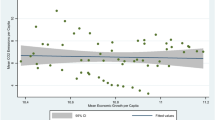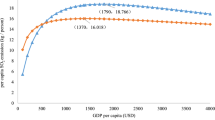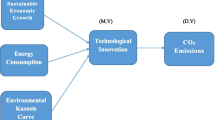Abstract
Irrespective of the vast array of empirical evaluations pertaining to the environmental Kuznets curve (EKC) hypothesis, both for India and other countries, previous studies, amid divergent submissions, inadvertently failed to highlight the relevant threshold that ensures significant reductions in environmental decay. Additionally, the implications of environmental-control technology on environmental quality are also lacking mostly in the context of Indian economy. Thus, this study enlists environmental-control technology and other relevant factors over the period 1980–2018 and employs the novel multiple threshold nonlinear ARDL technique, a model rarely applied in previous studies for updated empirical narratives. Accordingly, the empirical evidence rectifies that the variables converged to long-run equilibrium. Furthermore, from the tercile partial deviations, it is established that at the middle threshold (GDP2W2), pollution shrinks more significantly amid rising income, thereby validating the EKC hypothesis for India. Likewise, environmental-control technologies provided only a short-term insignificant carbon neutrality pathway, whereas they provided long-term insignificant emission increasing effects. This implies that the depth of such technology in India is inadequate to invoke cleaner environments at all times. Likewise, energy consumption and urbanization processes are significant environmental polluters, while trade openness provides insignificant long- and short-term carbon emission effects. Against this background, economic growth within the middle threshold promises a more sustainable environment amid rising national income at all times. Moreover, given its short-term outcomes, strengthening the depth of environmental-control technology is imperative to ensure a long-lasting clean environment in India.




Similar content being viewed by others
Data availability
The data can be made available on reasonable request.
References
Adebayo TS, Rjoub H (2021) Assessment of the role of trade and renewable energy consumption on consumption-based carbon emissions: evidence from the MINT economies. Environmental Science and Pollution Research, June. https://doi.org/10.1007/s11356-021-14754-0
Adebola Solarin S, Al-Mulali U, Ozturk I (2017) Validating the environmental Kuznets curve hypothesis in India and China: the role of hydroelectricity consumption. Renew Sustain Energy Rev 80(August):1578–1587. https://doi.org/10.1016/j.rser.2017.07.028
Adzawla W, Sawaneh M, Yusuf AM (2019) Greenhouse gasses emission and economic growth nexus of sub-Saharan Africa. Sci Afr 3:e00065. https://doi.org/10.1016/j.sciaf.2019.e00065
Ansari MA, Ahmad MR, Siddique S, Mansoor K (2020) An environment Kuznets curve for ecological footprint: evidence from GCC countries. Carbon Management, February 355–368. https://doi.org/10.1080/17583004.2020.1790242
Anwar MA, Zhang Q, Asmi F, Hussain N, Plantinga A, Zafar MW, Sinha A (2022) Global perspectives on environmental kuznets curve: a bibliometric review. Gondwana Res 103:135–145. https://doi.org/10.1016/j.gr.2021.11.010
Asiedu BA, Gyamfi BA, Oteng E (2021) How do trade and economic growth impact environmental degradation? New evidence and policy implications from the ARDL approach. Environmental Science and Pollution Research, May. https://doi.org/10.1007/s11356-021-13739-3
Bashir MF, Ma B, Bashir MA, Bilal, & Shahzad, L. (2021) Scientific data-driven evaluation of academic publications on environmental Kuznets curve. Environ Sci Pollut Res 28(14):16982–16999. https://doi.org/10.1007/s11356-021-13110-6
Bayer C, Hanck C (2013) Combining non-cointegration tests. J Time Ser Anal 34(1):83–95. https://doi.org/10.1111/j.1467-9892.2012.00814.x
Bello MO, Solarin SA, Yen YY (2018) The impact of electricity consumption on CO2 emission, carbon footprint, water footprint and ecological footprint: the role of hydropower in an emerging economy. J Environ Manage 219:218–230. https://doi.org/10.1016/j.jenvman.2018.04.101
Ben Nasr A, Gupta R, Sato JR (2015) Is there an environmental Kuznets curve for South Africa? A co-summability approach using a century of data. Energy Economics 52:136–141. https://doi.org/10.1016/j.eneco.2015.10.005
Bilgili F, Kuşkaya S, Khan M, Awan A, Türker O (2021a) The roles of economic growth and health expenditure on CO2 emissions in selected Asian countries: a quantile regression model approach. Environ Sci Pollut Res 28(33):44949–44972. https://doi.org/10.1007/s11356-021-13639-6
Bilgili F, Muğaloğlu E, Kuşkaya S, Bağlıtaş HH, Gençoğlu P (2019) Most up-to-date methodologic approaches. Environmental Kuznets Curve (EKC) 115–139. https://doi.org/10.1016/b978-0-12-816797-7.00010-2
Bilgili F, Nathaniel SP, Kuşkaya S, Kassouri Y (2021b) Environmental pollution and energy research and development: an environmental Kuznets curve model through quantile simulation approach. Environ Sci Pollut Res 28(38):53712–53727. https://doi.org/10.1007/s11356-021-14506-0
Bilgili F, Ozturk I, Kocak E, Kuskaya S, Cingoz A (2021c) The nexus between access to electricity and CO 2 damage in Asian Countries: the evidence from quantile regression models. https://doi.org/10.1016/j.enbuild.2021c.111761
Chang BH (2020) Oil prices and E7 stock prices: an asymmetric evidence using multiple threshold nonlinear ARDL model. Environ Sci Pollut Res 27(35):44183–44194. https://doi.org/10.1007/s11356-020-10277-2
Chien F, Hsu CC, Sibghatullah A, Hieu VM, Phan TTH, Hoang Tien N (2021) The role of technological innovation and cleaner energy towards the environment in ASEAN countries: proposing a policy for sustainable development goals. Economic Research-Ekonomska Istrazivanja 0:1–16. https://doi.org/10.1080/1331677X.2021.2016463
Chishti MZ, Sinha A (2022) Do the shocks in technological and financial innovation influence the environmental quality? Evidence from BRICS economies. Technol Soc 68(December 2021). https://doi.org/10.1016/j.techsoc.2021.101828
Danish, Ulucak R (2022) Analyzing energy innovation-emissions nexus in China: a novel dynamic simulation method. Energy 244:123010. https://doi.org/10.1016/j.energy.2021.123010
Danish, Wang Z (2019) Investigation of the ecological footprint’s driving factors: what we learn from the experience of emerging economies. Sustain Cities Soc 49(May). https://doi.org/10.1016/j.scs.2019.101626
Doğan B, Chu LK, Ghosh S, Diep Truong HH, Balsalobre-Lorente D (2022) How environmental taxes and carbon emissions are related in the G7 economies? Renewable Energy 187:645–656. https://doi.org/10.1016/j.renene.2022.01.077
Emre A, Wasif M, Victor F, Mert M (2022) Determinants of CO2 emissions in the BRICS economies : the role of partnerships investment in energy and economic complexity. 51(August 2021)
Erdoğan S, Yıldırım S, Yıldırım DÇ, Gedikli A (2020) The effects of innovation on sectoral carbon emissions: evidence from G20 countries. J Environ Manage 267(April):1–10. https://doi.org/10.1016/j.jenvman.2020.110637
Eregha PB, Adeleye BN, Ogunrinola I (2021) Pollutant emissions, energy use and real output in Sub-Saharan Africa (SSA) countries. Journal of Policy Modeling. https://doi.org/10.1016/j.jpolmod.2021.10.002
Everitt BS, Skrondal A (2010) The Cambridge dictionary of statistics. Cambridge University Press
Godil DI, Ahmad P, Ashraf MS, Sarwat S, Sharif A, Shabib-ul-Hasan S, Jermsittiparsert K (2021) The step towards environmental mitigation in Pakistan: do transportation services, urbanization, and financial development matter? Environ Sci Pollut Res 28(17):21486–21498. https://doi.org/10.1007/s11356-020-11839-0
Gormus S, Aydin M (2020) Revisiting the environmental Kuznets curve hypothesis using innovation: new evidence from the top 10 innovative economies. Environ Sci Pollut Res 27(22):27904–27913. https://doi.org/10.1007/s11356-020-09110-7
Grossman GM, Krueger AB (1995) Economic growth and the environment author ( s ): Gene M . Grossman and Alan B . Krueger Reviewed work ( s ): Published by : Oxford University Press. Quart J Econ 110(2):353–377
Güngör H, Abu-Goodman M, Olanipekun IO, Usman O (2021) Testing the environmental Kuznets curve with structural breaks: the role of globalization, energy use, and regulatory quality in South Africa. Environ Sci Pollut Res 28(16):20772–20783. https://doi.org/10.1007/s11356-020-11843-4
Gyamfi BA, Adedoyin FF, Bein MA, Bekun FV (2021) Environmental implications of N-shaped environmental Kuznets curve for E7 countries. Environ Sci Pollut Res 28(25):33072–33082. https://doi.org/10.1007/s11356-021-12967-x
Hao Y, Wu Y, Wang L, Huang J (2018) Re-examine environmental Kuznets curve in China: spatial estimations using environmental quality index. Sustain Cities Soc 42(August):498–511. https://doi.org/10.1016/j.scs.2018.08.014
Hashmi SM, Chang BH, Shahbaz M (2020) Asymmetric effect of exchange rate volatility on India’s cross-border trade: evidence from global financial crisis and multiple threshold nonlinear autoregressive distributed lag model. Australian Economic Papers, May, 1–34. https://doi.org/10.1111/1467-8454.12194
Javid M, Sharif F (2016) Environmental Kuznets curve and financial development in Pakistan. Renew Sustain Energy Rev 54:406–414. https://doi.org/10.1016/j.rser.2015.10.019
Jiang S, Tan X, Hu P, Wang Y, Shi L, Ma Z, Lu G (2022) Air pollution and economic growth under local government competition: evidence from China, 2007–2016. J Clean Prod 334(January 2020). https://doi.org/10.1016/j.jclepro.2021.130231
Jin C, Razzaq A, Saleem F, Sinha A (2021) Asymmetric effects of eco-innovation and human capital development in realizing environmental sustainability in China: evidence from quantile ARDL framework. Economic Research-Ekonomska Istraživanja 0:1–24. https://doi.org/10.1080/1331677x.2021.2019598
Jóźwik B, Gavryshkiv AV, Kyophilavong P, Gruszecki LE (2021) Revisiting the environmental Kuznets curve hypothesis: a case of Central Europe. Energies 14(12). https://doi.org/10.3390/en14123415
Kanjilal K, Ghosh S (2013) Environmental Kuznet’s curve for India: evidence from tests for cointegration with unknown structuralbreaks. Energy Policy 56:509–515. https://doi.org/10.1016/j.enpol.2013.01.015
Katircioğlu S, Katircioğlu S (2018) Testing the role of urban development in the conventional Environmental Kuznets Curve: evidence from Turkey. Appl Econ Lett 25(11):741–746. https://doi.org/10.1080/13504851.2017.1361004
Khan A, Muhammad F, Chenggang Y, Hussain J, Bano S, Khan MA (2020) The impression of technological innovations and natural resources in energy-growth-environment nexus: a new look into BRICS economies. Sci Total Environ 727:138265. https://doi.org/10.1016/j.scitotenv.2020.138265
Li X, Ozturk I, Majeed MT, Hafeez M, Ullah S (2022) Considering the asymmetric effect of financial deepening on environmental quality in BRICS economies: policy options for the green economy. J Clean Prod 331:129909. https://doi.org/10.1016/j.jclepro.2021.129909
Naili M, Lahrichi Y (2022) Banks’ credit risk, systematic determinants and specific factors: recent evidence from emerging markets. Heliyon 8:1–16. https://doi.org/10.1016/j.heliyon.2022.e08960
Neog Y, Yadava AK (2020) Nexus among CO2 emissions, remittances, and financial development: a NARDL approach for India. Environ Sci Pollut Res 27(35):44470–44481. https://doi.org/10.1007/s11356-020-10198-0
Nwani C, Effiong EL, Okpoto SI, Okere IK (2021) Breaking the carbon curse: the role of financial development in facilitating low-carbon and sustainable development in Algeria. African Development Review, January 2020. https://doi.org/10.1111/1467-8268.12576
Obiakor TR, Uche E, Das N (2022) Technology in society is structural innovativeness a panacea for healthier environments ? Evidence from developing countries. Technol Soc 70(March):102033. https://doi.org/10.1016/j.techsoc.2022.102033
Omoke PC, Uche E (2021) How does purchasing power in OPEC countries respond to oil price periodic shocks? Fresh evidence from Quantile ARDL specification. OPEC Energy Rev. https://doi.org/10.1111/opec.12216
Opuala CS, Omoke PC, Uche E (2022) Sustainable environment in West Africa: the roles of financial development, energy consumption, trade openness, urbanization and natural resource depletion. Int J Environ Sci Technol. https://doi.org/10.1007/s13762-022-04019-9
Pal D, Mitra SK (2015) Asymmetric impact of crude price on oil product pricing in the United States: an application of multiple threshold nonlinear autoregressive distributed lag model. Econ Model 51:436–443. https://doi.org/10.1016/j.econmod.2015.08.026
Pal D, Mitra SK (2016) Asymmetric oil product pricing in India: evidence from a multiple threshold nonlinear ARDL model. Econ Model 59:314–328. https://doi.org/10.1016/j.econmod.2016.08.003
Pal D, Mitra SK (2019) Asymmetric oil price transmission to the purchasing power of the U.S. dollar: a multiple threshold NARDL modelling approach. Resources Policy 64(September). https://doi.org/10.1016/j.resourpol.2019.101508
Pesaran MH, Shin Y (1999) Autoregressive distributed lag modeling approach to cointegration analysis. In Storm S (ed) Econometrics and economic theory in the 20th century: The Ragnar Frisch Centennial Symposium. Cambridge University Press, Cambridge, chapter 1
Pesaran MH, Shin Y, Smith RJ (2001) Bounds testing approach to the analysis of level relationships. J Appl Economet 16(3):289–326
Salari M, Javid RJ, Noghanibehambari H (2021) The nexus between CO2 emissions, energy consumption, and economic growth in the U.S. Economic Analysis and Policy 69:182–194. https://doi.org/10.1016/j.eap.2020.12.007
Shahbaz M, Solarin SA, Ozturk I (2016) Environmental Kuznets Curve hypothesis and the role of globalization in selected African countries. Ecol Ind 67:623–636. https://doi.org/10.1016/j.ecolind.2016.03.024
Sheikhzeinoddin A, Hassan Tarazkar M, Behjat A, Al-Mulali U, Ozturk I (2022) The nexus between environmental performance and economic growth: new evidence from the Middle East and North Africa region. J Clean Prod 331:129892. https://doi.org/10.1016/j.jclepro.2021.129892
Shin Y, Yu B, Greenwood-Nimmo M (2014) Modelling asymmetric cointegration and dynamic multipliers in a nonlinear ARDL framework. A Festschrift in Honour of Peter Schmidt (pp. 281–314). New York, NY: Springer
Shoaib HM, Rafique MZ, Nadeem AM, Huang S (2020) Impact of financial development on CO2 emissions: a comparative analysis of developing countries (D8) and developed countries (G8). Environ Sci Pollut Res 27(11):12461–12475. https://doi.org/10.1007/s11356-019-06680-z
Shujah-ur-Rahman, Chen S, Saud S, Saleem N, Bari MW (2019) Nexus between financial development, energy consumption, income level, and ecological footprint in CEE countries: do human capital and biocapacity matter? Environ Sci Pollut Res 26(31):31856–31872. https://doi.org/10.1007/s11356-019-06343-z
Sun H, Samuel CA, Kofi Amissah JC, Taghizadeh-Hesary F, Mensah IA (2020) Non-linear nexus between CO2 emissions and economic growth: a comparison of OECD and B&R countries. Energy 212:118637. https://doi.org/10.1016/j.energy.2020.118637
Tiba S, Frikha M (2020) EKC and macroeconomics aspects of well-being: a critical vision for a sustainable future. J Knowl Econ 11(3):1171–1197. https://doi.org/10.1007/s13132-019-00600-9
Uche E, Chang BH, Effiom L (2022) Household consumption and exchange rate extreme dynamics: multiple asymmetric threshold non-linear autoregressive distributed lag model perspective. International Journal of Finance and Economics, November 2020:1–14. https://doi.org/10.1002/ijfe.2601
Uche E, Effiom L (2021) Financial development and environmental sustainability in Nigeria: fresh insights from multiple threshold nonlinear ARDL model. Environ Sci Pollut Res. https://doi.org/10.1007/s11356-021-12843-8
Udemba EN, Güngör H, Bekun FV, Kirikkaleli D (2021) Economic performance of India amidst high CO2 emissions. Sustainable Production and Consumption 27:52–60. https://doi.org/10.1016/j.spc.2020.10.024
Ulucak R, Bilgili F (2018) A reinvestigation of EKC model by ecological footprint measurement for high, middle and low income countries. J Clean Prod 188:144–157. https://doi.org/10.1016/j.jclepro.2018.03.191
Umar M, Ji X, Kirikkaleli D, Xu Q (2020) COP21 roadmap: do innovation, financial development, and transportation infrastructure matter for environmental sustainability in China? J Environ Manag 271(June). https://doi.org/10.1016/j.jenvman.2020.111026
UNFCCC (2016) Report of the Conference of the parties on its twenty-first session, held in Paris from 30 November to 13 December 2015
Verheyen F (2013) Exchange rate nonlinearities in EMU exports to the US. Econ Model 32(1):66–76. https://doi.org/10.1016/j.econmod.2013.01.039
Villanthenkodath MA, Arakkal MF (2020) Exploring the existence of environmental Kuznets curve in the midst of financial development, openness, and foreign direct investment in New Zealand: insights from ARDL bound test. Environ Sci Pollut Res 27(29):36511–36527. https://doi.org/10.1007/s11356-020-09664-6
Villanthenkodath MA, Gupta M, Saini S, Sahoo M (2021) Impact of economic structure on the environmental Kuznets curve (EKC) hypothesis in India. J Econ Struct 10(1). https://doi.org/10.1186/s40008-021-00259-z
Yang B, Jahanger A, Ali M (2021) Remittance inflows affect the ecological footprint in BICS countries: do technological innovation and financial development matter? Environ Sci Pollut Res 28(18):23482–23500. https://doi.org/10.1007/s11356-021-12400-3
Zafar MW, Zaidi SAH, Khan NR, Mirza FM, Hou F, Kirmani SAA (2019) The impact of natural resources, human capital, and foreign direct investment on the ecological footprint: the case of the United States. Resour Policy 63(May). https://doi.org/10.1016/j.resourpol.2019.101428
Zhu L, Hao Y, Lu ZN, Wu H, Ran Q (2019) Do economic activities cause air pollution? Evidence from China’s major cities. Sustain Cities Soc 49(September 2018). https://doi.org/10.1016/j.scs.2019.101593
Acknowledgements
The authors most sincerely appreciate the timely processing of the manuscript by the Editor. We also sincerely appreciate the informed inputs of the four (4) anonymous reviewers whose inputs led to significant improvements of the manuscript.
Author information
Authors and Affiliations
Contributions
EU and ND conceptualized the idea. DN provided the initial draft. EU conducted the analysis and provided some editing. PB provided the literature section and proofread the manuscript.
Corresponding author
Ethics declarations
Ethical approval
Not applicable.
Consent to participate
Not applicable.
Consent for publication
Not applicable.
Additional information
Responsible Editor: Eyup Dogan
Publisher's note
Springer Nature remains neutral with regard to jurisdictional claims in published maps and institutional affiliations.
Electronic supplementary material
Below is the link to the electronic supplementary material.
Rights and permissions
Springer Nature or its licensor holds exclusive rights to this article under a publishing agreement with the author(s) or other rightsholder(s); author self-archiving of the accepted manuscript version of this article is solely governed by the terms of such publishing agreement and applicable law.
About this article
Cite this article
Uche, E., Das, N. & Bera, P. Re-examining the environmental Kuznets curve (EKC) for India via the multiple threshold NARDL procedure. Environ Sci Pollut Res 30, 11913–11925 (2023). https://doi.org/10.1007/s11356-022-22912-1
Received:
Accepted:
Published:
Issue Date:
DOI: https://doi.org/10.1007/s11356-022-22912-1




